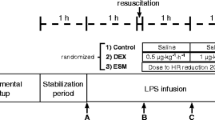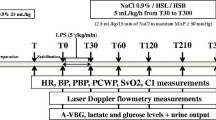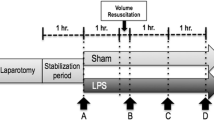Abstract
Objective
To determine whether epinephrine increases lactate concentration in sepsis through hypoxia or through a particular thermogenic or metabolic pathway.
Design
Prospective, controlled experimental study in rats.
Setting
Experimental laboratory in a university teaching hospital.
Interventions
Three groups of anesthetized, mechanically ventilated male Wistar rats received an intravenous infusion of 15 mg/kg Escherichia coli O127:B8 endotoxin. Rats were treated after 90 min by epinephrine (n=14), norepinephrine (n=14), or hydroxyethyl starch (n=14). Three groups of six rats served as time-matched control groups and received saline, epinephrine, or norepinephrine from 90 to 180°min. Mean arterial pressure, aortic, renal, mesenteric and femoral blood flow, arterial blood gases, lactate, pyruvate, and nitrate were measured at baseline and 90 and 180 min after endotoxin challenge. At the end of experiments biopsy samples were taken from the liver, heart, muscle, kidney, and small intestine for tissue adenine nucleotide and lactate/pyruvate measurements.
Measurements and results
Endotoxin induced a decrease in mean arterial pressure and in aortic, mesenteric, and renal blood flow. Plasmatic and tissue lactate increased with a high lactate/pyruvate (L/P) ratio. ATP decreased in liver, kidney, and heart. The ATP/ADP ratio did not change, and phosphocreatinine decreased in all organs. Epinephrine and norepinephrine increased mean arterial pressure to baseline values. Epinephrine increased aortic blood flow while renal blood low decreased with both drugs. Plasmatic lactate increased with a stable L/P ratio with epinephrine and did not change with norepinephrine compared to endotoxin values. Nevertheless epinephrine and norepinephrine when compared to endotoxin values did not change tissue L/P ratios or ATP concentration in muscle, heart, gut, or liver. In kidney both drugs decreased ATP concentration.
Conclusions
Our data demonstrate in a rat model of endotoxemia that epinephrine-induced hyperlactatemia is not related to cellular hypoxia.






Similar content being viewed by others
References
Task Force of the American College of Critical Care Medicine, Society of Critical Care (1999) Practice parameters for hemodynamic support of sepsis in adult patients in sepsis. Crit Care Med 27:639–660
Van Der Poll T, Lowry SF (1997) Epinephrine inhibits endotoxin-induced IL-1 beta production: roles of tumor necrosis factor-alpha and IL-10. Am J Physiol 273:R1885–R1890
Levy B, Nace L, Bollaert PE, Dousset B, Mallie JP, Larcan A (1997) Comparison of norepinephrine and dobutamine to epinephrine for hemodynamics, lactate metabolism and gastric tonometric variables in septic shock. A prospective, randomized study. Intensive Care Med 23:282–287
Meier-Hellmann A, Reinhart K, Bredle DL, Specht M, Spies CD, Hannemann L (1997) Epinephrine impairs splanchnic perfusion in septic shock. Crit Care Med 25:399–404
Rudis MI, Basha MA, Zarowitz BJ (1996) Is it time to reposition vasopressors and inotropes in sepsis? Crit Care Med 24:525–537
Duranteau J, Sitbon P, Teboul JL, Vicaut E, Anguel N, Richard C, Samii K (1999) Effects of epinephrine, norepinephrine, or the combination of norepinephrine and dobutamine on gastric mucosa in septic shock. Crit Care Med 27:893–900
Ensinger H, Weichel T, Lindner KH, Grunert A, Georgieff M (1995) Are the effects of noradrenaline, adrenaline and dopamine infusions on VO2 and metabolism transient? Intensive Care Med 21:50–56
Totaro RJ, Rapper RF (1997) Epinephrine-induced lactic acidosis following cardiopulmonary bypass. Crit Care Med 25:1693–1699
Bollaert PE, Robin-Lherbier B, Mallie JP, Nace L, Escanye JM, Larcan A (1994) Effects of sodium bicarbonate on striated muscle metabolism and intracellular pH during endotoxic shock. Shock 1:196–200
Levy B, Valtier M, de Chillou C, Bollaert PE, Cane D, Mallie JP (1999) Beneficial effects of L-canavanine, a selective inhibitor of inducible nitric oxide synthase, on lactate metabolism and muscle high energy phosphates during endotoxic shock in rats. Shock 11:98–103
Hargrove DM, Lang CH, Bagby GJ, Spitzer JJ (1989) Epinephrine-induced increase in glucose turnover is diminished during sepsis. Metabolism 38:1070–1076
Hargrove DM, Skrepnik N, Lang CH, Bagby GJ, Spitzer JJ (1990) Role of insuline in the blunted metabolic response of septic rats to epinephrine. Metabolism 39:1180–1185
Piper RD, Cook DJ, Bone RC, Sibbald WJ (1996) Introducing critical appraisal to studies of animal models investigating novel therapies in sepsis. Crit Care Med 24:2059–2070
Schlichtig R, Klion HA, Kramer DJ, Nemoto EM (1992) Hepatic dysoxia commences during O2 supply dependence. J Appl Physiol 72:1499–1505
Green LC, Wagner DA, Glogowski J, Skipper PL, Wishnok JS, Tannenbaum SR (1982) Analysis of nitrate, nitrite and [15 N] nitrate in biological fluids. Anal Biochem 126:131–138
Atkinson DE (1968) The energy charge of the adenylate pool as a regulatory parameter. Interaction with feed-back modifiers. Biochemistry 7:4030–4034
Van Lambalgen AA, van Kraats AA, Mulder MF, Teerlink T, van den Bos GC (1994) High-energy phosphates in heart, liver, kidney and skeletal muscle of endotoxemic rats. Am J Physiol 266:H1581–H1587
Astiz M, Rackow EC, Weil MH, Schumer W (1988) Early impairment of oxidative metabolism and energy production in severe sepsis. Circulatory Shock 26:311–320
Levy B, Sadoune LO, Gelot AM, Bollaert PE, Nabet P, Larcan A (2000) Evolution of lactate/pyruvate and arterial ketone body ratio in the early course of catecholamine treated septic shock. Crit Care Med 28:114–119
VanderMeer TJ, Wang H, Fink MP (1995) Endotoxemia causes ileal mucosal acidosis in the absence of mucosal hypoxia in a normodynamic porcine model of septic shock. Crit Care Med 23:1217–1226
Gutierrez G (2000) Sepsis, cellular energy metabolism, and tissue adenosine triphosphate concentration. Crit Care Med 28:2664–2665
Tanaka J, Sato T, Kamiyama Y, et al (1982) Bacteremic shock: aspects of high-energy metabolism of rat liver during E coli injection. J Surg Res 33:49–57
Hotchkiss RS, Song SK, Neil JJ, Chen RD, Manchester JK, Karl IE, Lowry OH, Ackerman JJ (1991) Sepsis does not impair tricarboxylic acid cycle in the heart. Am J Physiol 260:C50–C57
Liaudet L, Fishman D, Markert M, Perret C, Feihl F (1997) L-Canavanine improves organ function and tissue adenosine triphosphate levels in rodent endotoxemia. Am J Respir Crit Care Med 155:1643–1648
Schmidt H, Weigand MA, Schmidt W, Plaschke K, Martin E, Bardenheuer HJ (2000) Effect of dopexamine on intestinal tissue concentrations of high-energy phosphates and intestinal release of purine compounds in endotoxemic rats. Crit Care Med 28:1979–1984
Revelly JP, Liaudet L, Frascarolo P, Joseph JM, Martinet O, Markert M (2000) Effects of norepinephrine on the distribution of intestinal blood flow and tissue adenosine triphosphate content in endotoxic shock. Crit Care Med 28:2500–2506
Katz A, Sahlin K (1988) Regulation of lactic acid production during exercise J Appl Physiol 65:509–518
Connett RJ, Honig CR, Gayeski TE (1990) Defining hypoxia: a systems of VO2, glycolysis energetics, and intracellular PO2. J Appl Physiol 68:833–842
Giraud GD, MacCannel KL (1984) Decreased nutrient blood flow during dopamine and epinephrine induced intestinal vasodilatation. J Pharmacol Exp Ther 214–220
Chasiotis D, K Sahlin, E Hultman (1983) Regulation of glycogenolysis in human muscle in response to epinephrine infusion. J Appl Physiol 54:45–50
James JH, Fang CH, Schrantz SJ, Hasselgren PO, Paul RJ, Fischer JE (1999) Stimulation of both aerobic glycolysis and Na+-K+-ATPase activity in skeletal muscle by epinephrine or amylin. Am J Physiol 277:E176–E186
James JH, Fang CH, Schrantz SJ, Hasselgren PO, Paul RJ, Fischer JE (1996) Linkage of aerobic glycolysis to sodium-transport in rat skeletal muscle. Implications for increased muscle lactate production in sepsis. J Clin Invest 98:2388–2397
James JH, Luchette FA, McCarter FD, Fischer JE (1999) Lactate is an unreliable indicator of tissue hypoxia in injury or sepsis. Lancet 354:505–508
Uusaro A, Hartikainen J, Parviainen M, Takala J (1995) Metabolic stress modifies the thermogenic effect of dobutamine in man. Crit Care Med 23:674–680
Palsson J, Ricksten SE, Houltz E, Lundin S (1997) Effects of dopamine, dopexamine and dobutamine on renal excretory function during experimental sepsis in conscious rats. Acta Anaesthesiol Scand 4:392–398
Salak N, Pajk W, Knotzer H, Hofstotter H, Schwarz B, Mayr A, Labeck B, Kafka R, Ulmer H, Mutz N, Hasibeder W (2001) Effects of epinephrine on intestinal oxygen supply and mucosal oxygen tension in pigs. Crit Care Med 29:367–373
Acknowledgements
The authors thanks Pr. O. Lesur (Sherbrooke, Québec, Canada) and Pr. R. Nevière (Lille, France) for their helpful comments. This work was carried out in the Laboratoire d'Exploration Fonctionnelle Rénale, Faculté de Médecine, Vandoeuvre-les-Nancy, France. The study was supported in part by a grant from Nestle-Perrier France.
Author information
Authors and Affiliations
Corresponding author
Additional information
An editorial regarding this article can be found in the same issue (http://dx.doi.org/10.1007/s00134-002-1596-8)
Rights and permissions
About this article
Cite this article
Levy, B., Mansart, A., Bollaert, PE. et al. Effects of epinephrine and norepinephrine on hemodynamics, oxidative metabolism, and organ energetics in endotoxemic rats. Intensive Care Med 29, 292–300 (2003). https://doi.org/10.1007/s00134-002-1611-0
Received:
Accepted:
Published:
Issue Date:
DOI: https://doi.org/10.1007/s00134-002-1611-0




